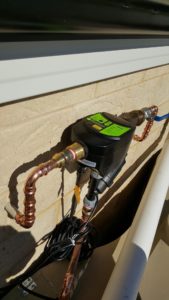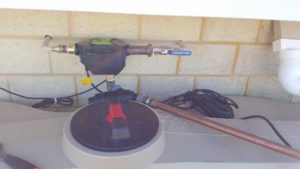Rainwater & Grey Water Systems

A Rainwater tank switching valve.
Installing a rain water tank on your home or business can save you a substantial amount of water, which you can use for irrigation, drinking, or to be used for your toilets/showers/laundry instead of using scheme water. Depending on what type of outcome you want, it can be a very simple installation, it isn’t very difficult to change some fixtures over to rainwater and with new products on the market, its possible to switch between rain water and scheme water automatically. Usually a rainwater tank will be retrofitted somewhere close to gutters, with gravity allowing water to run into the tank, from there it can be manually piped out/used or connected to a pressure pump system that will allow it be run at mains pressure to whenever you require the water. Some installations have sump pits, which is an underground pit located somewhere accessible that allows your down pipes/storm water system to be connected, with a submersible pump installed, transfers the water to a holding tank where the water is pumped into a mains like system. Underground rainwater tanks can also be used to harvest rainwater and then be used for drinking water or for supplying fixtures.
When collecting rainwater from your roof, its important to make sure your gutters are kept clean, flashing are not lead, and gutter protection is installed. A first flush diverter is a good product to install, the purpose of this valve is to dump the first couple of liters of rain water to waste, allowing any material, dust, dirt, debris etc to be flushed out of the system before collecting it into your rain water tank. It is also important to find the best area for the rain water tank, and to accurately calculate the amount of water you may collect over your roof space, and how much water you will use, it’s often best to oversize your water tanks to collect as much water as possible. A correctly positioned rain water tank and system could save you up to 100,000L of scheme water a year, and roughly save you about $200 a year on water cost – depending on how much you pay for water, how much you use, etc.
Grey Water Systems

Mains water enters from the rhs, tank water is pumped into the bottom of the valve and water is automatically switched between tank and mains. Perfect for flushing toilets.
Installing a grey water system on your home or business can be more involved, depending on the plumbing drainage design may require modification to allow the system to work seamlessly with the original drainage system. Greywater is re-used for irrigation and can be used for flushing water for toilets. The problem with grey water re-use is that you need to be aware of the products you use, cleaning, hygiene etc as it can clog your drip system and cause a lot of maintenance issues that can be costly. Making sure to use septic / grey water friendly washing liquid / powder, cleaning products, body washes, soap, and hair products helps ensure build up is kept to a minimum. Some people choose separate grey water units for each fixture (One for the laundry, basins etc), however it’s best to install a grey water system during new construction, so separate drain lines can be run and the system installed.
Rain Water Tank
Tanks for residential rainwater collection systems are usually manufactured out of concrete or plastic, the tank itself may also have a rubber liner or bladder inside. Most above ground tank systems can be chosen to suit the installation, they come in a range of sizes perfect for retro-fitting into spaces, eaves or awkward areas. Underground rainwater collection tanks can also come in Plastic, concrete, concrete with rubber lining, or come in the form of a modular box construction with an external waterproof liner – Tanks can also be fabricated to suit the type of installation. Most concrete and plastic tanks are modular, meaning that can be easily stacked on top of each other, or moved, placed in tight spaces, and still provide the required capacity. Of course the only problem with below ground tanks is maintenance and if there is any trafficable loading.
PRICING
| Description | Price |
|---|---|
| Requires a phone call & quote | POA |
